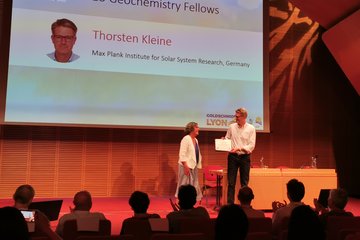Alle Typen
21.
Zeitschriftenartikel
Sun-like stars produce superflares roughly once per century. Science 386, S. 1301 - 1305 (2024)
22.
Zeitschriftenartikel
Testing MURaM and MPS-ATLAS against the quiet solar spectrum. Astronomy and Astrophysics 681, S. A81 (2024)
23.
Zeitschriftenartikel
TESS Asteroseismic Analysis of HD 76920: The Giant Star Hosting an Extremely Eccentric Exoplanet. The Astrophysical Journal 945, S. 20 (2023)
24.
Zeitschriftenartikel
Intensity contrast of solar network and faculae close to the solar limb, observed from two vantage points. Astronomy and Astrophysics 678, S. A163 (2023)
25.
Zeitschriftenartikel
Intensity contrast of solar network and faculae close to the solar limb, observed from two vantage points. ASTRONOMY & ASTROPHYSICS (2023)
26.
Zeitschriftenartikel
Spectropolarimetric investigation of magnetohydrodynamic wave modes in the photosphere: First results from PHI on board Solar Orbiter. Astronomy and Astrophysics 674, S. A109 (2023)
27.
Zeitschriftenartikel
Wavefront error of PHI/HRT on Solar Orbiter at various heliocentric distances. Astronomy and Astrophysics 675, S. A61 (2023)
28.
Zeitschriftenartikel
Coronal voids and their magnetic nature. Astronomy and Astrophysics 678, S. A196 (2023)
29.
Zeitschriftenartikel
Interaction of solar inertial modes with turbulent convection. A 2D model for the excitation of linearly stable modes. Astronomy and Astrophysics 673, S. A124 (2023)
30.
Zeitschriftenartikel
The ratio of horizontal to vertical displacement in solar oscillations estimated from combined SO/PHI and SDO/HMI observations. Astronomy and Astrophysics 673, S. A84 (2023)
31.
Zeitschriftenartikel
Magnetic fields inferred by Solar Orbiter: A comparison between SO/PHI-HRT and SDO/HMI. Astronomy and Astrophysics 673, S. A31 (2023)
32.
Zeitschriftenartikel
Stereoscopic disambiguation of vector magnetograms: first applications to SO/PHI-HRT data. Astronomy and Astrophysics 677, S. A25 (2023)
33.
Zeitschriftenartikel
Imaging individual active regions on the Sun's far side with improved helioseismic holography. Astronomy and Astrophysics 669, S. A89 (2023)
34.
Zeitschriftenartikel
Imaging individual active regions on the Sun's far side with improved helioseismic holography. Astronomy and Astrophysics 669, S. A89 (2023)
35.
Zeitschriftenartikel
Direct assessment of SDO/HMI helioseismology of active regions on the Sun's far side using SO/PHI magnetograms. Astronomy and Astrophysics 674, S. A183 (2023)
36.
Zeitschriftenartikel
Revised Extinctions and Radii for 1.5 Million Stars Observed by APOGEE, GALAH, and RAVE. The Astrophysical Journal Supplement Series 264, S. 41 (2023)
37.
Zeitschriftenartikel
Superflares on solar-like stars. A new method for identifying the true flare sources in photometric surveys. Astronomy and Astrophysics 668 (2022)
38.
Zeitschriftenartikel
Impact of spatially correlated fluctuations in sunspots on metrics related to magnetic twist. Astronomy and Astrophysics 664, S. A183 (2022)
39.
Zeitschriftenartikel
Theory of solar oscillations in the inertial frequency range: Amplitudes of equatorial modes from a nonlinear rotating convection simulation. Astronomy and Astrophysics 666, S. A135 (2022)
40.
Zeitschriftenartikel
Theory of solar oscillations in the inertial frequency range: Linear modes of the convection zone. Astronomy and Astrophysics 662, S. A16 (2022)











